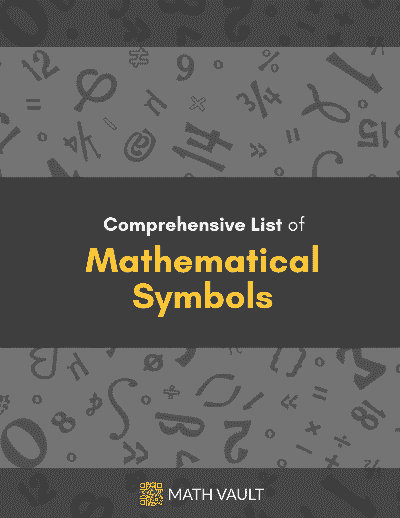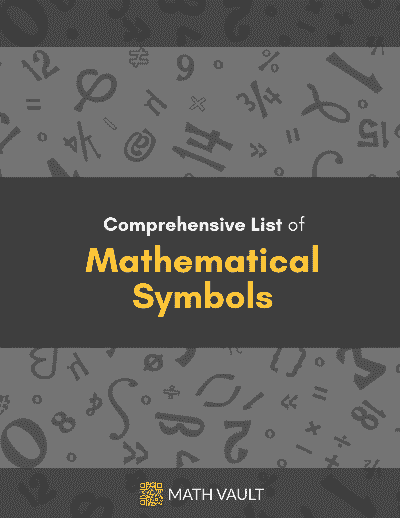In basic mathematics, many different symbols exist and are adopted widely. The following is a compilation of the most commonly-used symbols in arithmetic and common mathematics, along with other symbols whose usage covers multiple subfields of mathematics.
For readability purpose, these symbols are categorized by their function into tables. Other comprehensive lists of symbols — as categorized by subject and type — can be also found in the relevant pages below (or in the navigational panel).
Table of Contents

Prefer the PDF version instead?
Get the master summary of mathematical symbols in eBook form — along with each symbol’s usage and LaTeX code.
Mathematical Constants
In common mathematics, constants are often used to denote key natural numbers, integers, real numbers and complex numbers. The following table documents the most common of these — along with their name, usage and function.
| Symbol Name | Explanation | Example |
|---|---|---|
| $0$ (Zero) | Additive identity of common numbers | $5 + 0 = 0 + 5 = 5$ |
| $1$ (One) | Multiplicative identity of common numbers | $6 \times 1 = 6$ |
| $\sqrt{2}$ (Square root of $2$) | Positive number whose square is $2$. Pythagoras’ constant. Approximately $1.414$. | $\sqrt{2}$ is often considered to be the “simplest” irrational number. |
| $e$ (Euler’s number) | Base of natural logarithm. Limit of sequence $\left( 1+\frac{1}{n} \right)^n$. Approximately $2.718$. | $\ln e = 1$ |
| $\pi$ (Pi, Archimedes’ constant) | Ratio of a circle’s circumference and diameter. Half-circumference of unit circle. | $\pi$ is irrational and approximately $3.1416$. |
| $\varphi$ (Phi, golden ratio) | Ratio between two positive numbers $a > b$ such that $\frac{a+b}{a} = \frac{a}{b}$. Positive root of polynomial $x^2-x-1$. | $\varphi = \dfrac{1+\sqrt{5}}{2} \approx 1.618$ |
| $i$ (Imaginary unit) | Principal square root of $-1$. Foundational component of complex numbers. | $i^2 = (-i)^2 = -1$ |
Delimiters
Delimiters are symbols used to signal the separation between different independent mathematical entities. These include the common delimiters such as parentheses, brackets and braces, and the use of delimiters in the context of intervals.
Common Delimiters
| Symbol Name | Explanation | Example |
|---|---|---|
| $.$ | Decimal separator | $15.35 + 8.25 = 23.60$ |
| $,$ | Object separator | $\{ 5, 0, 2 \}$ |
| $:$ | Ratio indicator | $4 : 3 = 1024 : 768$ |
| $(), [], \{ \}$ | Order-of-operation indicators | $\left[(2+3) + 4\right] + 5$ |
| $( )$ | Tuple-indicator | $(4, 7, 11, 15)$ |
Intervals
| Symbol Name | Explanation | Example |
|---|---|---|
| $[a, b]$ | Closed interval from $a$ to $b$ | $\pi \in [3, 5]$ |
| $(a, b)$ | Open interval from $a$ to $b$ | $(1, 9) =$ $\{x \in \mathbb{R} \mid \\ 1 < x < 9\}$ |
| $[a, b)$ | Right-open interval from $a$ to $b$ | $[e, \pi) \subseteq [1, \infty)$ |
| $(a, b]$ | Left-open interval from $a$ to $b$ | $0 \notin (0, 100]$ |
Operators
Operators are placeholder symbols used to denote mathematical operations, which take one or multiple mathematical objects to another similar object. In common mathematics, these include the arithmetic operators, and other number-related unary operators.
Arithmetic Operators
| Symbol Name | Explanation | Example |
|---|---|---|
| $x + y$ | Sum ($x$ plus $y$) | $\dfrac{3}{5} + \dfrac{2}{3} = \dfrac{19}{15}$ |
| $x-y$ | Difference ($x$ minus $y$) | $13-1.\overline{3} = 11.\overline{6}$ |
| $-x$ | Additive inverse (negative $x$) | $(-1.5) + 1.5 =0$ |
| $x \times y$, $x \cdot y$, $xy$ | Product ($x$ times $y$) | $2 \times (3 + 5) = \\ 6 + 10$ |
| $x \div y$, $\, x / y$ | Quotient ($x$ over $y$) | $16 \div 2.5 = 6.4$ |
| $\dfrac{x}{y}$ | Fraction of $x$ over $y$ | $\dfrac{3}{8}=0.375$ |
| $x^y$ | Power ($x$ raised to $y$) | $3^{10} = 9^5$ |
| $\pm$ | Plus-and-minus operator | With the quadratic formula, we have that $x = \dfrac{-b \pm \sqrt{\Delta}}{2a}$. |
| $\mp$ | Minus-and-plus operator | $5 \pm (-3) = 5 \mp 3$ |
Number-related Unary Operators
| Symbol Name | Explanation | Example |
|---|---|---|
| $\sqrt{x}$ | Principal square root of $x$ | $\sqrt{30}= \\ \sqrt{2 \cdot 3 \cdot 5}$ |
| $\sqrt[n]{x}$ | nth root of $x$ | $\sqrt[3]{125}=5$ |
| $|x|$ | Absolute value of $x$ | $|-5| = |5| = 5$ |
| $x \%$ | $x$ percent | $5 \% \doteq \dfrac{5}{100}$ |
Relational Symbols
In mathematics, relational symbols are used to denote mathematical relations, which take one or multiple mathematical objects to form full mathematical sentences. In arithmetic and common mathematics, these include the relational symbols related to equality and comparison.
Equality-based Relational Symbols
| Symbol Name | Explanation | Example |
|---|---|---|
| $x \doteq y$, $x \overset{df}{=} y$, $x := y$ | $x$ is defined as $y$ | $\mathbb{R}_+ \doteq \\ \{ x \in \mathbb{R} \mid x > 0 \}$ |
| $x = y$ | $x$ is equal to $y$ | $ \pi = \dfrac{C}{d}$ |
| $x \ne y$ | $x$ is not equal to $y$ | $\sqrt{3} \ne 1.7$ |
| $x \approx y$ | $x$ is approximately equal to $y$ | $\dfrac{5}{7} \approx 0.714$ |
| $f(x) \propto g(x)$ | Function $f$ is directly proportional to function $g$ | $\dfrac{\pi}{2} x^2 \propto 3x^2$ |
Comparison-based Relational Symbols
| Symbol Name | Explanation | Example |
|---|---|---|
| $x < y$ | $x$ is less than $y$ | $2 < e$ |
| $x > y$ | $x$ is greater than $y$ | $\dfrac{13}{4} > 3$ |
| $x \le y$ | $x$ is less than or equal to $y$ | $1 \le n^2$ |
| $x \ge y$ | $x$ is greater than or equal to $y$ | $n! \ge 2^n$ for $n \ge 4$ |
Notational Symbols
Notational symbols are often conventions and shorthands which don’t fall into the categories of constants, delimiters, operators and relational symbols. The following table documents some of these in the context of common mathematics — along with their usage and meaning.
| Symbol Name | Explanation | Example |
|---|---|---|
| $\ldots, \cdots$ | Horizontal ellipsis symbols | $3 + 7 + 11 + \cdots + 43$ |
| $\infty$ | Infinity symbol | $\dfrac{1}{1} + \dfrac{1}{2} + \cdots = \infty$ |
| $Q. E. D.$, $\square$, $\blacksquare$ | QED / End-of-the-proof symbols | Hence $1 + \cdots + n = \frac{n(n+1)}{2}$, as desired. $\, \blacksquare$ |
| ※, ⨳ | Contradiction symbols | Squaring both sides of the equation yields that $2 < 1$. ⨳ |
For the master list of symbols, see mathematical symbols. For lists of symbols categorized by type and subject, refer to the relevant pages below for more.
- Arithmetic and Common Math Symbols
- Geometry and Trigonometry Symbols
- Logic Symbols
- Set Theory Symbols
- Greek, Hebrew, Latin-based Symbols
- Algebra Symbols
- Probability and Statistics Symbols
- Calculus and Analysis Symbols

Prefer the PDF version instead?
Get the master summary of mathematical symbols in eBook form — along with each symbol’s usage and LaTeX code.
Additional Resources
- Definitive Guide to Learning Higher Mathematics: A standalone, 10-principle framework for tackling higher mathematical learning, thinking and problem solving efficiently
- 10 Commandments of Higher Mathematical Learning: An illustrated web guide on 10 scalable rules for learning higher mathematics


Symbols like greater than (>), less than (<), greater than or equal to (≥), and less than or equal to (≤) are used for comparisons.
Yes Tarhib!